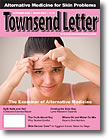|
There have been more than 10,000 studies on soy and or its components
since 1991. Those studies can be broken down to endpoints dealing
with either nutritional benefits or the metabolic pathways involved
with the prevention or treatment of chronic diseases such as cancer,
coronary artery diseases, diabetes, multiple sclerosis, muscular
dystrophy, and diseases affecting other vital organs. The more advanced
studies are involved with DNA, up-regulation or down-regulation
of gene expressions, genetic repair mechanisms, and metabolic pathways.
The research has been positive in almost all of the studies. The
FDA approved a health claim for the cholesterol-lowering effects
of soy protein and the reduction of risk from heart disease. One
study on prostate cancer shows soy isoflavones may reduce prostate
cancer risks by 50%. Breast cancer studies have been controversial,
focusing on the potential increased risk of developing estrogen
receptor positive breast cancers (ER+), speeding up the growth of
ER+ breast cancers, or as a pharmaceutical company claimed, reducing
the effectiveness of Tamoxifen (by way of the isoflavones in soy
products). In spite of this last claim, studies show synergism between
Tamoxifen and soy. Tamoxifen by itself was 26% effective, soy protein
isolate by itself was 36% effective, and the two together were 62%
effective. The combination of Tamoxifen and soy resulted in smaller
breast tumors than Tamoxifen alone.
Epidemiological studies examining the relationship between soy intake
and health outcomes have involved Asian populations and therefore
evaluated the intake of traditional fermented foods such as tofu
and other soy products that are derived from whole or dehulled soybeans.
In contrast, few animal or human intervention studies have involved
fermented products or whole soy foods. Instead, soy concentrates,
soy isolates, isolated isoflavone mixtures, supplements, or pure
genistein are generally used. Some studies have evaluated full-fat
or defatted soy flours or textured soy protein (usually mixtures
of soy concentrates and soy flour). There are dozens of soy products
used for research, and they differ markedly in micro (isoflavone,
saponin, phytic acid, phytosterol, vitamin, and mineral content)
and macro (protein, fat, and carbohydrate) content.
These differences exist even when comparing similar compounds like
soy flours, concentrates, and isolates used in studies. The isoflavone
content expressed in a study may not be accurately interpreted,
because in fermented soy products, some of the glycoside (40% sugar
form) of isoflavones is converted to aglycones (sugar-free form).
Researchers often express the isoflavone content of the product
fed to subjects without indicating the breakdown between the glycoside
and aglycone forms of isoflavones in the product being used. The
sugar moiety does not contribute to the biological activity of the
isoflavones, and the amount of aglycone present is 60% of the total
weight of the aglycone form of isoflavones. Therefore, 100 mg of
isoflavones may represent anywhere from 60-100 mg of active isoflavones,
depending on the type of soy product.
The level of daidzin and daidzein present in a product may produce
significant differences in the results experi-enced by a cancer
patient because these two isoflavones produce a potent anticancer
compound equol in 30-50% of the people in the United States. Equol
is not produced in everyone, because its production is a result
of the isofla-vones daidzein and daidzin fermentation by gut microflora.
Antibiotics destroy the equol-producing gut microflora. It takes
about nine months to re-establish the equol-producing microflora
in the gut naturally. Several years ago, the National Cancer Institute
announced that "users of antibiotics are at higher risk for
cancer." The 4400+ isoflavones in fruits and vegetables are
fermented in the intestines, and anticancer metabolites are produced.
When beneficial mi-croflora are destroyed by antibiotics, they do
not produce equol and other anticancer metabolites. Therefore, users
of antibiotics are at higher risk for cancers.
A soy study using soy flour, soy protein concentrate, an isolate,
or a fermented soy powder or beverage might mean a difference between
32%, 21%, 3%, or 0% carbohydrate content. Differences in the anticancer
compounds, the quantity, and bioavailability can be astronomical.
Bioavailability is important with these compounds, because studies
show that, with dietary isoflavones, what goes in does not equal
what comes out. The excreted isoflavones in humans is less than
the total isoflavone consumption. The difference between isoflavone
consumption and excretion goes into the cellular tissues and repairs
DNA, up-regulates or down-regulates gene expressions, and influences
metabolic pathways. Isoflavone compounds generally are 500-3000
daltons in size. Fermentation breaks down these large molecules
to individual molecules or smaller molecular clusters that are more
bioavailable. Fermentation produces soy metabolites like glyceollins
and others that have anticancer properties. Glyceollins are being
studied at Tulane University on breast and ovarian cancers.
The chemical composition of soy concentrates or isolates is affected
by processing techniques, because water and alcohol washing are
used to concentrate the proteins by removing the sugars and oligosaccharides
from soy. This removes some of the low-molecular weight peptides
(those below 2000 that contain high amounts of sulfur amino acids).
Alcohol washing also removes most of the isoflavones and saponins
from the product. Research shows alcohol washing may substantially
alter the protein matrix and structure. Fermentation breaks down
the isoflavones to smaller molecules, produces isoflavone metabolites,
and makes them more bioavailable. Spectrographic analysis shows
vast differences between Haelan's fermented soy beverage isoflavone
spectrum when compared to other commercial isoflavone products being
marketed (see Figures 1-4). An analysis of Haelan's fermented soy
beverages shows they contain RNA, DNA, polysaccharides, amino acids,
isoflavones and their metabolites, the Bowman Birk (BBI) protease
inhibitor compound, saponins, phytosterols, and phytic acid compounds
in addition to a branched fatty acid compound known as 13 Methyltetradecanoic
Acid (MTD-13). This compound is produced solely in Haelan's fermentation
process and is not present in other soy products. Studies with the
MTD-13 by itself exhibited significant tumor shrinkage in human
prostate and liver cancers. Apoptosis in leukemia cells was induced
in two hours.
In spite of the positive soy research reports that are reported,
articles on the Internet and elsewhere knock soy for controversial
reasons. One anti-soy article approves of fermented soy products
but is critical of non-fermented soy products. Non-fermented soy
products contain growth-stunting compounds and chemotrypsin-inhibiting
compounds that affect the consumer's ability to digest proteins.
Fermentation removes or de-activates these undesirable compounds.
Another article states that the World Health Article provided soy
foods to starving people in Sudan, and they were later found to
be deficient in minerals. The anti-soy group claimed that the phytates
in soy, because of their mineral-binding capacity (which protects
us from colon cancers), caused mineral depletion in these Sudanese
people. Later studies found that these Sudanese people were deficient
in minerals prior to their soy consumption. In spite of the published
studies stating there is no mineral deficiency caused by soy, the
anti-soy groups continue the myth that soy causes mineral deficiency.
Similarly, a recent study on soy shows soy only affects thyroid
function in people who are deficient in iodine. The anti-soy group
still claims soy affects thyroid function but forgets to state it
is only in those people deficient in iodine. Another contested complaint
against soy is that it causes smaller brains in people. This was
first presented at an international soy conference I attended in
California several years ago. Two female researchers said they tested
some elderly Japanese people living in Hawaii, and discerned that
those subjects had smaller brains than normal. When asked what they
ate during their lifetime, the elderly Japanese subjects answered
fish, vegetables, soy, and meat. The researchers concluded that
soy must have been the culprit that caused these people to have
smaller brains than normal. What else could it have been? I would
have directed attention to the fact that these elderly Japanese
people were much closer to the nuclear radiation after the atomic
bombs destroyed Hiroshima and Nagasaki just prior to the end of
World War II. These people may have suffered radiation damage directly
as a result of closer proximity to the nuclear blasts or indirectly
from eating migratory fish, vegetables, etc. that were possibly
damaged by atmospheric deposition of radioactive particles in water
and soils involved with their food supply. It is difficult to say
what actually caused these elderly Japanese people to have smaller
brains. There is no evidence that elderly Japanese or Chinese people
have smaller brains associated with their historical consumption
of soy. Studies on soy show it reduces the risk of Alzheimer's by
34%, improves blood flow to the brain, and increases brain function
in humans.
Without question, soy is controversial. Does soy have a dark side,
or is it good? Meat is good, but too much meat is bad. How much
soy, if any, is good, or is it all bad? Are some soy products better
than others? Do the benefits of soy outweigh the undesirable side
effects? How do we determine what is correct? Clinical studies generally
give us insight in determining what is factual and what is not.
The problem is the soy studies have no uniformity when referring
to soy products and components in the scientific literature. In
addition, there is a lack of statistical data, and that data involve
poorly defined test substances. There is also controversy over the
validity of the research models and approaches. Some researchers
worry that isoflavones at low levels (below 50 mg) may be estrogenic,
whereas the whole soy with higher isoflavone levels is anti-estrogenic.
A study on healthy women by Dr. Jane Lu, University of Texas Medical
School, Galveston, Texas showed healthy women who consumed the whole
soy had lower total circulating levels of estrogens that were 30-40
% lower than women who did not consume the whole soy. Studies in
Japan (Nagata et al.) showed that Japanese women who consumed the
whole soy had 25% lower levels of circulating estrogens than those
who did not consume the whole soy. These results are clearly anti-estrogenic
and would be beneficial to those with estrogen receptor-positive
cancers.
One published study performed by seven Harvard OB-Gyn oncologists
at Massachusetts General Hospital recommended clinical trials with
Haelan 951 fermented soy beverages, a commercially available product,
for Platinum Chemotherapy-resistant ovarian cancers. This study
reported the long-term stabilization of a patient who was previously
non-responsive to chemotherapy. Similarly, cancer patient histories
with Haelan 951 fermented soy use were evaluated by the National
Cancer Institute (NCI) as part of their "Best Case Series."
NCI graded several of the reported cases (breast and liver cancers)
as being "persuasive" cases. "Persuasive" is
the highest NCI rating for a cancer treatment's effectiveness.
A study performed in Germany on the breast cancer cell line BT474
with Doxorubicin (chemo for breast cancers) showed a 4.6% cancer
cell survival rate with 5% by volume chemotherapy treatment. The
Haelan 951 fermented soy produced a 4.8% cancer cell survival with
3% by volume in the blood. Doxorubicin at .5% resulted in an 82%
cancer cell survival but, when combined with the 3% fermented soy,
resulted in a cancer cell kill five times stronger than the Doxorubicin
produced by itself. The synergistic effect of the combination is
partly explained by the fact that the fermented soy increased pro-apoptotic
conditions in the cancer cells and raises the level of P21 in cancer
cells. Re-activation of the P53 tumor suppressor protein produces
higher levels of P21 in cancer cells. Additional insight into the
synergism between soy and chemotherapy treatments was reported by
Karmanos Cancer Center, University of Michigan in Detroit. Their
report says, "all cancer cells within two hours of being hit
with chemotherapy try to mutate. The mutation pathway of the cancer
cell is Nuclear Factor Kappa Beta (NF-Kb), and the soy isoflavones
shut off the mutation capability completely, and you get eight to
ten times greater cancer cell kill than chemotherapy does by itself."
With glowing reports like this extolling the benefits of soy, why
is there confusion on determining if soy is beneficial for the treatment
of estrogen-positive breast, ovarian, and prostate cancers? At the
heart of the estrogen receptor-positive breast cancer controversy
are a few studies that are out of synch with the thousands of positive
cancer studies on soy. The controversy began when a study at the
University of Illinois removed the ovaries from rats, implanted
estrogen receptor-positive (ER+) breast cancers and then gave them
a low level of genistein (one of 12 isoflavones in soybeans). Under
these conditions, the tumor grew. The word quickly spread, "don't
give soy products to ER+ breast cancer patients because soy makes
those cancers grow. Later studies showed that when Tamoxifen alone
was used under the same conditions, the tumors also grew. When higher
levels of genistein were used, the tumors shrank. When the whole
soy was used, the tumors shrank. When the ovaries were left in the
rats, those that received the soy were better off than the control
group that did not receive the soy. After looking at thousands of
incomparable soy studies, the position presented by Dr. Mark Messina,
representing the soy industry, is that women have no problem with
consuming the "whole" soy but should be cautious about
consuming isolates of soy.
The National Cancer Institute (NCI) spent $20 million looking at
anticancer compounds in fruits and vegetables and found five classes
of superstar anticancer compounds, all of which are in the whole
soybean. Those are isoflavones, protease inhibitors, saponins, phytosterols,
and phytic acid compounds. There are six major and six minor isoflavones
in the isoflavone group. After identifying these anticancer compounds,
the NCI spent $2.9 million studying them. The results were published
in the Journal of the National Cancer Institute
on April 17, 1991. This publication spurred the extensive cancer
research on soy. It is easy to recognize that a whole soy product
may have all of these soy anticancer compounds in them, whereas
soy supplement products may only contain a few of isoflavones in
them and none of the other anticancer compounds naturally found
in the whole soybean.
Dr. Ann Kennedy, David Brandon, and Irvin Liener, in studies at
the University of Pennsylvania, noted that the soybean BBI protease
inhibitor (BBI) either inhibits or prevents development of experimentally
induced colon, oral, lung, liver, and esophageal cancers. Results
suggest an important role for trypsin inhibition in suppression
of the promotional stage of carcinogenesis. These compounds prevent
conversion of normal cells to malignant state even at very late
stages in carcinogenesis and cause an irreversible suppressive effect
on the carcinogenic process. In addition, these compounds have been
shown to suppress oncogene expression and inhibit carcinogen-induced
protease activity. Kennedy commented that the lowest effective dietary
levels of protease inhibitors used in their animal studies (0.1%)
could be achieved in humans by modifying the diet to include soy
products. An analysis of tofu has revealed that the protease-inhibitor
content varied significantly between the samples from four to 30
micrograms of BBI per gram of product. There is a wide variation
of BBI content among varieties of soybeans. Studies show Haelan
951 contains the highest BBI content of any commercially available
soy product. Studies show BBI benefits muscular dystrophy, multiple
sclerosis, and cancer patients.
The health benefits gained from any soy product depend on many factors.
There are more than 10,000 varieties of soybeans. The phytochemical
content in soybeans varies 50%, depending on the minerals in the
soil, and an additional 50%, depending on the age of the beans when
they are picked. Processing greatly affects the resulting end product.
Storage and processing of the soybeans affects the concentrations
and bioavailability of the surviving compounds in the end product.
To demonstrate the difference between commercially available soy
isoflavone products and Haelan 951 fermented soy beverages, the
following comparisons are presented. In summary, all soy products
are not created equally, and the benefits derived are not the same.
This makes it very difficult to evaluate the soy studies that are
researched. The studies with Haelan 951 fermented soy are easier
to evaluate because the same product was used in all the studies.
The results achieved with this product may not be achieved with
other commercial soy products of lesser quality.
Figure 1: 1H NMR spectrum of Haelan
951 and genistin; corresponding proton groups and signals marked
by arrows (red and green).
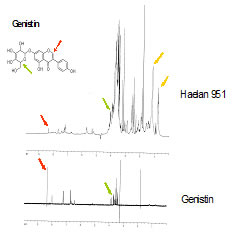
To determine the actual amount of isoflavones
relative to the total contents of a soy capsules, high-field NMR
spectroscopy was used as described above to non-destructively identify
via integration the proportions of low molecular weight metabolites
in the sample solution, combined in groups. This required identifying
the isoflavones in the 1H NMR spectrum of Haelan 951. This was achieved,
for example, by taking the 1H NMR spectrum of genistin, the genistein
glucoside and identifying the respective signals in the NMR spectrum
of Haelan 951 (see Figure 2, red and green arrows). The orange arrows
in the Haelan spectrum represent saturated fatty acids such as 13
MTD. The proportion of isoflavones is clearly identifiable in the
Haelan 951 spectrum.
Figure 2 shows the isoflavone content in each product via orange
and green bars. Product 1 contains hardly any detectable amounts
of the soy isoflavones. In addition, the middle portion of the spectrum
indicates that Product 1 largely consists of only one simple sugar
and fatty acids.
Figure 2: 1H NMR spectra of Product 1 and
Haelan 951
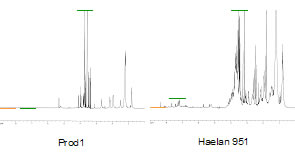
Figure 3 displays a comparison of the spectra
of Product 2 and Haelan 951. Again, in addition to revealing the
marginal amount of aromatic compounds in Product 2, Figure 3 illustrates
that the compared Product 2 largely consists of sugars and fillers.
Figure 3: 1H NMR spectra of Product 2 and Haelan
951
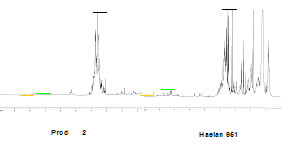
Conclusion
We need to recognize all soy products are not created equal. In
addition, we need to recognize most soy studies were not "soy"
studies but studies with isolated components taken from the soybean.
A study with genistein is not an isoflavone study or a soy study.
It is a study with genistein (one of the 12 isoflavones in soy)
and should be reported as a study with genistein. The study should
state the genistein concentration, form (glycoside or aglycone),
and conditions used in the study. Interpretation of the many reported
"soy studies" has been difficult because the soy products
or components of the soy used in the studies were not the same and
were poorly identified. We can't compare apples to oranges. Amid
the inconsistent results in "soy" studies, we do find
consistency in the studies with Haelan's fermented soy on cancers
and other health benefits. The results are consistent because the
same "soy product" was used in the studies. Results of
these studies have been consistent, superior, and duplicated in
humans. Haelan's processing and inclusion of the vast spectrum of
anticancer compounds found in the whole soybean have demonstrated
synergism that are not matched in studies with only one or a few
of these isolated compounds.
Consumers need to recognize there are little or no isoflavones in
many commercial products. In addition, sugars and fillers represent
a major component of many commercial isoflavone products. Spectrographic
comparisons between Haelan 951 and commercially available isoflavone
products show Haelan contains not only greater amounts of the isoflavones
but a vast spectrum of other anticancer compounds that are not present
in soy isoflavone products. The comparison of the isoflavone portions
in the 1H NMR spectra shown in Figure 4 reveals that in addition
to the known isoflavones genistin, genistein, daidzein, etc., Haelan
951 contains a number of interesting compounds not specifically
characterized so far that have likely been generated in the special
fermentation process.
Pilot studies on tumor cells and subsequently on a group of patients
with breast, ovarian, or prostate carcinoma demonstrated a positive
influence of Haelan 951 in terms of reduced tumor growth and significant
improvement of the patients' general condition. Dr. Doris Bachg's
working group at Gemeinschaftspraxis fur Laboratoriumsmedizin, Recklinghausen,
Germany, was able to demonstrate on a genetic level that Haelan
951 enhances the expression of P21, which leads to a stop of the
cell cycle and thus suppresses cancer growth in prostate, ovarian,
and breast cancer patients alike. P21 is located at a prominent
position in the cell cycle and is activated by P53.
Haelan 951 consists of many components, the number of which has
been significantly increased via the special type of fermentation
when compared to an untreated simple soy extract. In mixtures of
so many soy components, it is always unclear which of the many soy
constituents is responsible for an observed effect: is it one component
or a facultative effect of several substances, or does the mixture
only work indirectly by triggering a type of placebo effect at some
place in the metabolism (metabolome) via a comparatively insignificant
substance? Clinical trials and research on Haelan are ongoing.
Figure 4: A comparison of the isoflavone
content in Product #1 and Haelan 951
In addition, many other beneficial compounds in Haelan are identified.
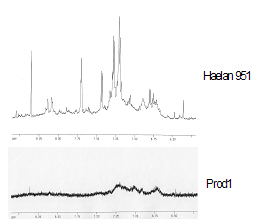
|



![]()
![]()
![]()
